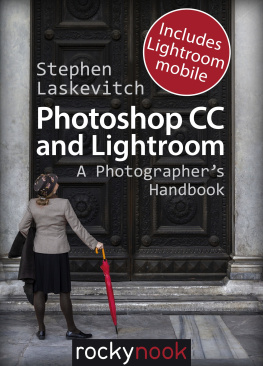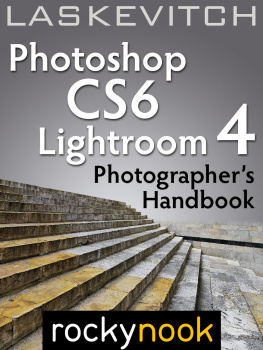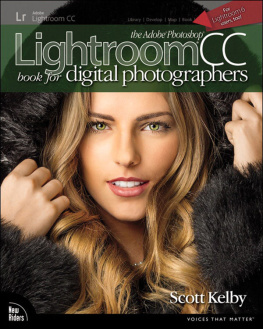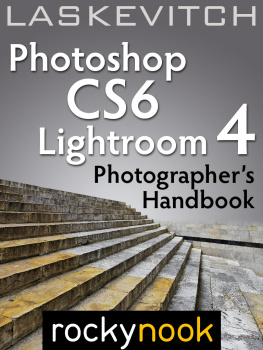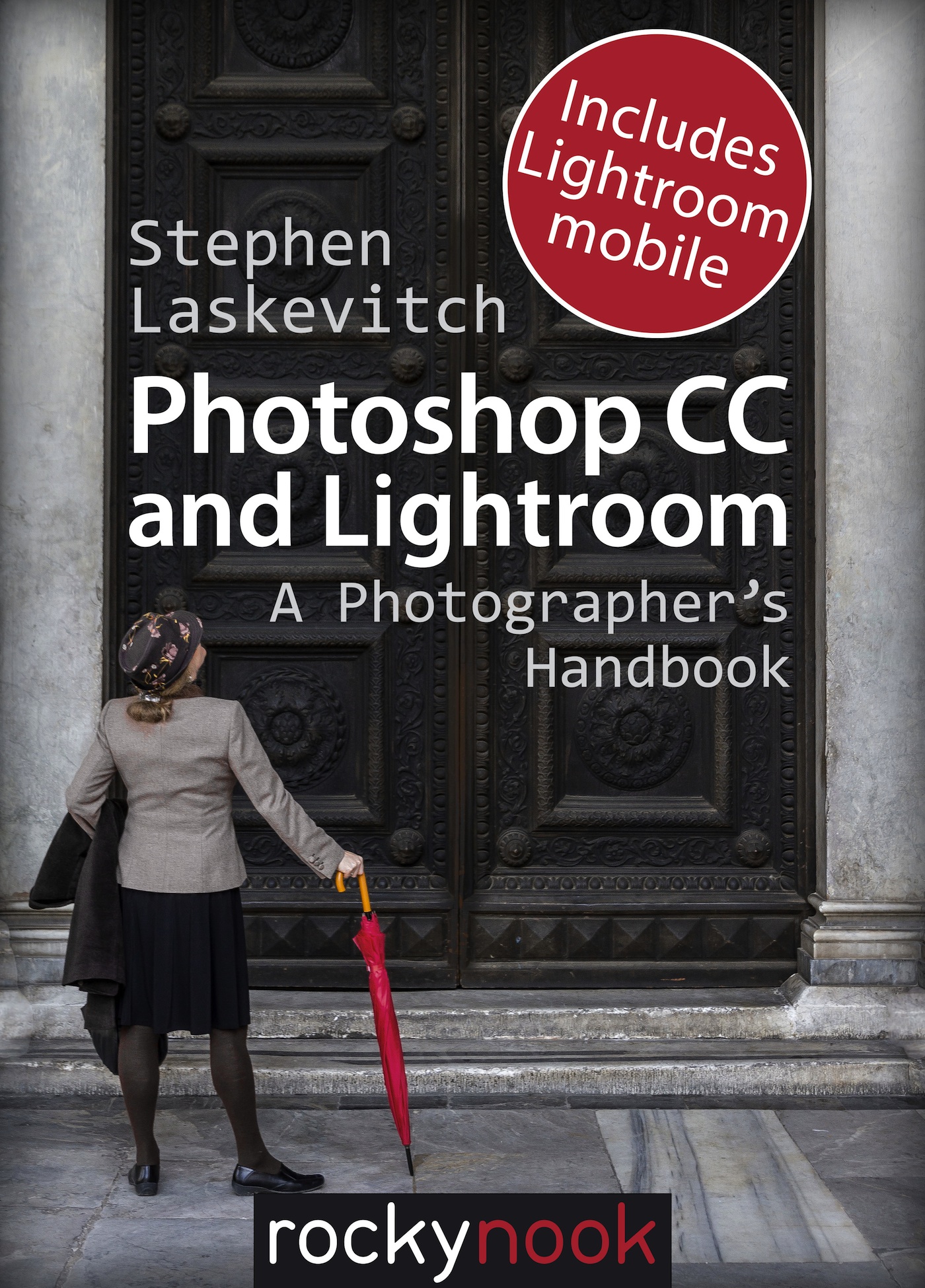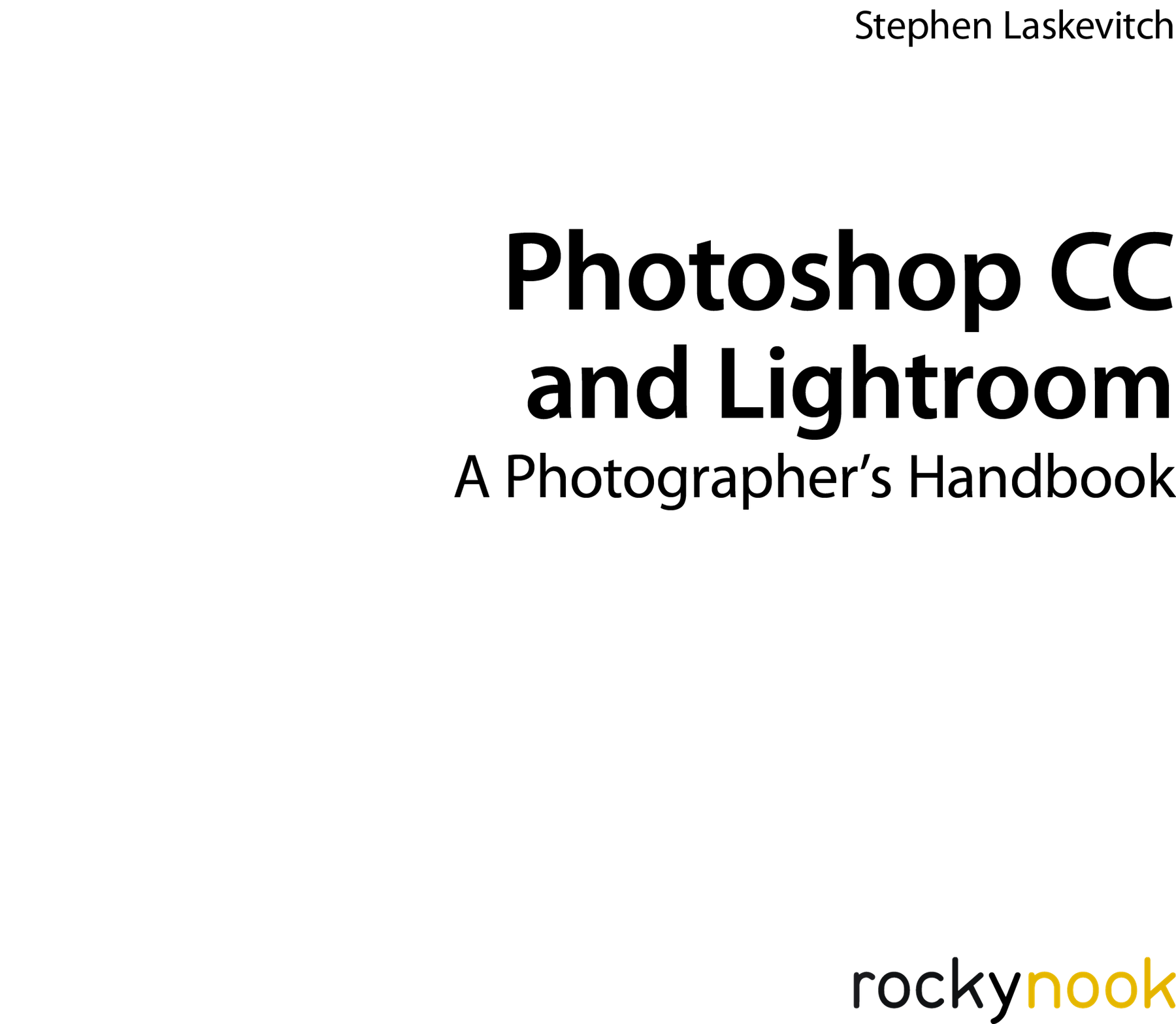Stephen Laskevitch (www.luminousworks.com)
Editor: Joan Dixon
Copyeditor: Cynthia Anderson, Vanessa McVay
Layout: Stephen Laskevitch
Cover Design: Helmut Kraus, www.exclam.de
Printer: Versa Press, Inc. through Four Colour Print Group
Printed in the USA
ISBN: 978-1-937538-58-3
1st Edition 2014
2014 by Stephen Laskevitch
Rocky Nook, Inc.
802 E. Cota Street, 3rd Floor
Santa Barbara, CA 93103
www.rockynook.com
Distributed by OReilly Media
1005 Gravenstein Highway North
Sebastopol, CA 95472
Library of Congress Cataloging-in-Publication Data
Laskevitch, Stephen.
Photoshop CC and Lightroom: A Photographers Handbook / by Stephen Laskevitch.
pages cm
Includes bibliographical references and index.
ISBN 978-1-937538-58-3 (softcover : alk. paper)
1. Adobe Photoshop--Handbooks, manuals, etc. 2. Photography--Digital techniques--Handbooks, manuals, etc. I. Title.
TR267.5.A3L369 2014
777--dc23
2014021742
All rights reserved. No part of the material protected by this copyright notice may be reproduced or utilized in any form, electronic or mechanical, including photocopying, recording, or by any information storage and retrieval system, without written permission of the publisher.
Many of the designations in this book used by manufacturers and sellers to distinguish their products are claimed as trademarks of their respective companies. Where those designations appear in this book, and Rocky Nook was aware of a trademark claim, the designations have been printed in caps or initial caps. All product names and services identified throughout this book are used in editorial fashion only and for the benefit of such companies with no intention of infringement of the trademark. They are not intended to convey endorsement or other affiliation with this book. Unless otherwise stated, the product names and trademarks mentioned in the text are the registered property of their respective owners and are subject to the appropriate laws.
While reasonable care has been exercised in the preparation of this book, the publisher and author assume no responsibility for errors or omissions, or for damages resulting from the use of the information contained herein or from the use of the discs or programs that may accompany it.
This book is printed on acid-free paper.
Acknowledgements
Many thanks to my students. I wrote this book to be a complement to the time you spend in my classroom. I hope you and the educators who use this book find it a means to great creative ends. There have been many of you whove shaped not only my teaching, but also my humanity. You make it obvious that I found the right career.
This book was written and built with Adobe InDesign. I am so grateful to Douglas Waterfall, InDesign engineer and architect, who is responsible for so much in the program that is wonderful, and Chris Kitchener, the product manager whos overseen the products great development for the last years.
Thank you, Bob Peterson, for being mindful of the better things in Life and inspiring me with your fine photography and humanity.
In fact, thanks are owed to all my friends and adopted family, for tolerating my neglect. Well talk soon.
To my wife, Carla Fraga, I owe more than gratitude. No one deserves such a wonder, let alone me. Thanks for letting me share your life.
Thank you too, reader, for choosing this book.
Steve Laskevitch
July 2014
www.luminousworks.com
Table of Contents

Introduction
In some ways, digital technology has fundamentally changed photography and printing. Photographers have almost unlimited options to achieve the precise image that they intend. Printing has become infinitely more flexible and pushed closer to the control of the image creatoryou. The level of control at our disposal now exceeds even some of the most powerful darkroom techniques used in the past. This power and flexibility is dazzling, even confusing, to many.
The Adobe Photoshop products are some of the most complex programs many of us will ever use. There is a reason Photoshop has become a verb. Despite that, my goal is to present them in a reasonably accessible way. Although we are provided with thousands of complex techniques for editing images, most users (and most images) dont need all of that complexity. In fact, only a few steps are needed to get the vast majority of images to shine. In this book, Ill introduce you to the processes that I and my students have found most valuable: from organizing a large image library, through editing density, contrast, and color, to more detailed processing like sharpening, basic retouching, and converting images from color to black-and-white. The workflow discussed is complete, but I will not discuss the extreme manipulations often considered Photoshop mischief.
In this books two main sections, youll find both the foundational concepts and vocabulary youll need to use the software discussed, and the pieces youll need to build your full photographic workflow from capture through print or online output. Lets get working.
About This Book
Who Should Use This Book
This book is for those who want to learn the basic tools and image editing steps within Photoshop and Lightroom to create professional looking images. This, of course, includes photographers and graphic designers, but also a wide range of technicians and office workers who simply want to do more effective image editing. This book provides insight into the creation of good images, but doesnt showcase wow-factor Photoshop techniques. I also dont pull any punches. I include all the key techniques necessary for good image editing: using layers and layer blending, color correction, printer profiles, and more.
Most readers should have a good grasp of working with computers so they will have no problem navigating computer menus and dialog boxes, or dragging a mouse. I do not demand that the reader have any experience with Photoshop, although many readers who have a good, basic understanding of Photoshop will find that this book deepens their understanding.
Steps for Using This Book
This book has two key sections. Section 1: The Setup includes three chapters: ImportantTerms & Concepts, System Configuration, and The Interface: A Hands-On Tour. The first chapter familiarizes the reader with the key concepts behind color and digital images, as well as some thoughts on how cameras convert light to data. The brief second chapter will help you decide how to configure your hardware and software settings, including certain application preference settings youll want to configure correctly early on for the kinds of images you work with. The third chapter, the most likely to earn dog-ears or bookmarks on its pages, covers the layout and general use of the software applications well be using.

